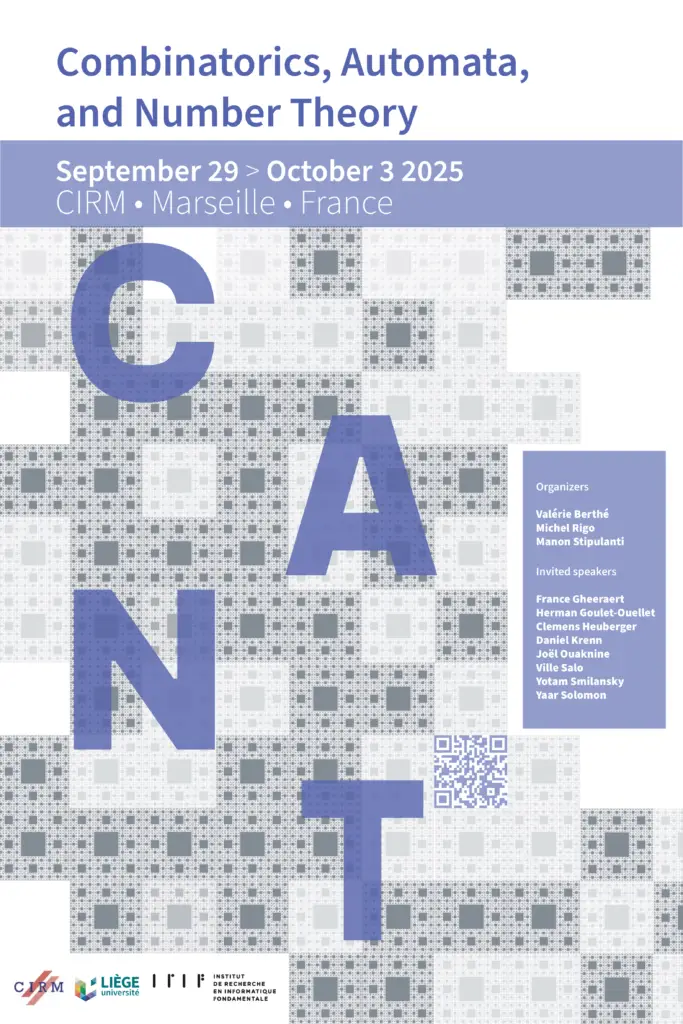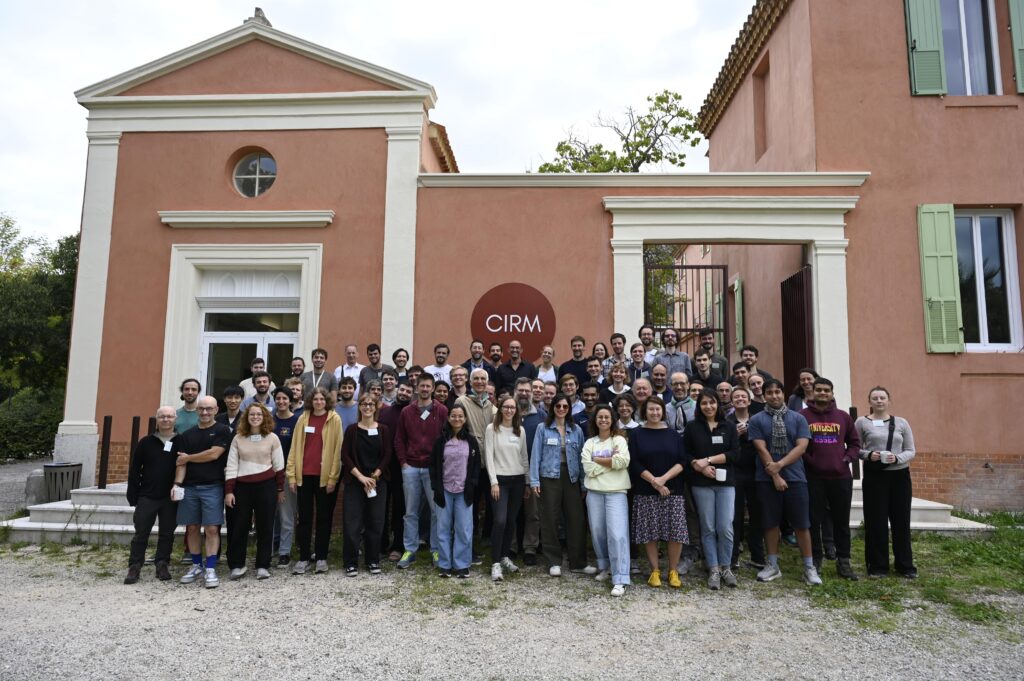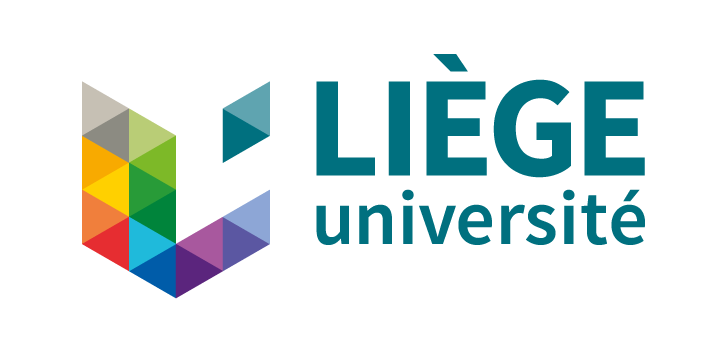RESEARCH SCHOOL - CONFERENCE
Combinatorics, Automata, and Number Theory (CANT)
Ecole-conférence de Combinatoire, d’Automates et de Théorie des Nombres (CANT)
29 September – 3rd October, 2025
Scientific Committee
Comité scientifique
Boris Adamcezwski (CNRS, Université Claude Bernard Lyon 1)
Valérie Berthé (CNRS, IRIF, Université Paris Cité)
Michael Drmota (TU Wien)
Edita Pelantová (Czech Technical University Prague)
Narad Rampersad (University of Winnipeg)
Michel Rigo (University of Liège)
Manon Stipulanti (University of Liège)
Reem Yassawi (Queen Mary University of London)
Organizing Committee
Comité d’organisation
Valérie Berthé (CNRS, IRIF, Université Paris Cité)
Michel Rigo (University of Liège)
Manon Stipulanti (University of Liège)
Each topic will be covered by a 3-hour lecture.
Contributed talks consist in 30-minute presentations.
A poster session will be organized during the week.
Du 29 septembre 2025 au 3 octobre 2025, la 5ème édition de l’école CANT aura lieu au CIRM à Marseille, France. CANT est un acronyme pour Combinatoire, Automates et Théorie des nombres. Les deux premières éditions de l’école se sont tenues à Liège (Belgique) en 2006 et 2009, tandis que les deux dernières éditions ont eu lieu au CIRM en 2012 et 2016.
Le CANT se veut à la fois une école internationale et une conférence internationale. Pour atteindre ces objectifs complémentaires, le symposium est structuré autour de six conférences complétées par de courtes présentations, une session de posters et du temps pour la collaboration scientifique. La complémentarité du CANT est l’une de ses forces : nous avons à cœur d’investir dans la formation des doctorants et des jeunes chercheurs tout en accueillant des chercheurs « seniors » du domaine.
La page web (locale) de l’événement est http://www.discmath.ulg.ac.be/CANT2025/. Vous y trouverez des détails sur la manière de s’inscrire, de demander un soutien financier et de soumettre une présentation ou un poster.
SPEAKERS
France Gheeraert (Université Picardie Jules Vernes): Dendric and eventually dendric words
Abstract: Introduced a decade ago by Berthé et al., dendric words include codings of regular interval exchange transformations and strict episturmian words, two majorly studied generalizations of Sturmian words. Eventual dendricity was later defined by Dolce and Perrin as the natural dynamical closure of dendricity. Both properties limit the behavior of letters surrounding finite words and induce combinatorial restrictions such as (eventually) affine factor complexity. In this course, we survey some of the known properties of dendric and eventually dendric words, especially those related to return words.
Herman Goulet-Ouellet (Czech Technical University Prague): Profinite methods in symbolic dynamics
Abstract: The aim of this course is to present the interplay between symbolic dynamics and profinite semigroup theory, highlighting a diversity of viewpoints: algebraic, combinatorial, and dynamical. The exposition will be divided in three parts. The first consists in an introduction to the theory of profinite semigroups, including some elements of general structure theory. A special emphasis is put on free profinite monoids in connection with automata theory. The second part centers around a key theorem of Almeida which links minimal shift spaces to the structure of free profinite monoids, via the topological closure of uniformly recurrent languages. As an interesting byproduct, Almeida’s theorem provides profinite conjugacy invariants for minimal shift spaces. The third and final part of the course further explores specific aspects of the topic, for instance in relation with return words or bifix codes.
Clemens Heuberger (Alpen-Adria-University Klagenfurt) and Daniel Krenn (Paris Lodron University of Salzburg, Austria) : Regular sequences: properties, analysis, and how-to in SageMath
Abstract: Regular sequences — introduced by Allouche and Shallit in 1992 — are a framework to represent sequences. They can be specified by matrix products related to the digit expansions of the arguments. They are closely related to Rational Series as introduced by Berstel and Reutenauer in 1988. A prototypical example is the sum of digits function. In this course, we cover their definition and properties, provide details on some examples, discuss asymptotic results, and selected details on how to handle them in the free open-source mathematics software system SageMath.
Joël Ouaknine (Max Planck Institute, Saarland University): On Expansions of Monadic Second-Order Logic with Power Predicates
Abstract: Büchi famously established the decidability of the monadic second-order (MSO) theory of the structure (N;<) in his 1962 seminal paper, in so doing bringing to light a profound connection between logic and automata theory. His work was quickly followed by further decidability results concerning expansions of (N;<) by various arithmetic predicates (such as powers of 2, powers of 3, perfect squares, factorial numbers, etc.), but only one at a time. These results, due to Elgot and Rabin, relied on the novel « contraction method », a form of effective profinite ultimate periodicity. Last year, exploiting and combining techniques from dynamical systems and number theory, Berthé et al. investigated the decidability (N;<) expanded with several power predicates simultaneously. This mini-course will review some of the key relevant classical techniques and results from the 1960s to today.
Ville Salo (University of Turku): Wang's algorithm and beyond
Abstract: Wang’s algorithm is a classical method for (partially) solving the emptiness problem of a subshift of finite type. We look at various generalizations of this idea, such as semilinear sets, automatic configurations and finitely-generated groups. We also discuss the limits of such methods, as well as practical implementations.
Yaar Salomon (Ben-Gurion university of the Negev) and Yotam Smilansky (Manchester University):
Bounded displacement and biLipschitz equivalence in aperiodic order
Bounded displacement and biLipschitz equivalence in aperiodic order
Abstract: A point set in Euclidean space is called Delone if it is uniformly discrete and relatively dense. These sets are always infinite and discrete, with examples ranging from perfectly ordered lattices through aperiodic configurations to randomly disordered sets. A natural question concerns the intermediate behaviour: given a non-lattice Delone set, in what ways is it still « equivalent » to a lattice? The course offers a survey on Bounded displacement (BD) and biLipschitz (BL) equivalence relations on Delone sets, covering fundamental results and equivalence criteria. Discrepancy estimates play an important role, providing a measure of how well a discrete point set approximates a given volume. Through a blend of theory and examples, the course aims to equip participants with a robust understanding of how discrepancy, BD, and BL equivalence interact, highlighting recent advances on sets arising from cut-and-project schemes and aperiodic substitution tilings.
SHORT TALKS
Gulizar Sedanur Albayrak (Simon Fraser University) A refinement of Christol’s theorem for sparse algebraic power series
Quentin Aristote (Université Paris-Cité, INRIA) Number rings are effectively almost strong Fatou
Pierre Arnoux (Aix-Marseille université) Nonstationary Markov Partitions and Multidimensional Continued Fraction Algorithms
Haritha Cheriyath (University of Chile) Perturbations for Coded systems
Annika Huch (Kiel University) Jumbled scattred factors
Pascal Jelinek (Technical University of Leoben) Joint distribution of the sum of digits function in two bases
Gandhar Girish Joshi (The Open University) Hamiltonian words in the Thue-Morse word and the Fibonacci word
Pavol Kebis (Institute of Science and Technology Austria) Transcendence of Series Related to Sturmian Words over an Algebraic Base
Martina Moravcova (Czech Technical University) Attractors of words coding beta-integers
Steven Robertson (University of Manchester) Number walls of automatic sequences
Lucía Rossi (Vienna University of Technology) Digit expansions in algebraic basis
Mai-Linh Trân Công (Université de Lorraine) Shapes of potential counterexamples to Nivat’s conjecture
Mihir Vahanwala (Max Planck Institute for Software Systems) Preservation theorems for transducer outputs
Benjamin Ward (La Trobe University) Sets of very exact approximation order
Maria Clara Werneck (Université Paris Cité) Low Symbolic Discrepancy for Tribona





